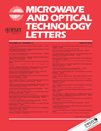K-band, low-power CMOS injection-locked divide-by-three circuit using shunt-peaking and current-bleeding techniques
Abstract
A CMOS divide-by-three injection-locked frequency divider having a wide input locking range of 23–27 GHz is proposed.The wide locking range is achieved by combining the shunt-peaking and current-bleeding techniques. The proposed circuit is fabricated using a 0.18-μm RF CMOS process, and the measured operation range (i.e., total locking range) is 4.32 GHz (from 23.17 to 27.49 GHz) for an input injection power of +4 dBm. The power consumption is 4.28 mW at a supply voltage of 1.2 V. The second- and third-order harmonic suppressions are 38.05 and 37.89 dBc, respectively, for a divided output frequency of 8.4 GHz. The output phase noise under lock at an offset of 1 MHz with an input injection power of +4 dBm is −139 dBc/Hz. © 2012 Wiley Periodicals, Inc. Microwave Opt Technol Lett 54:577–579, 2012; View this article online at wileyonlinelibrary.com. DOI 10.1002/mop.26648




